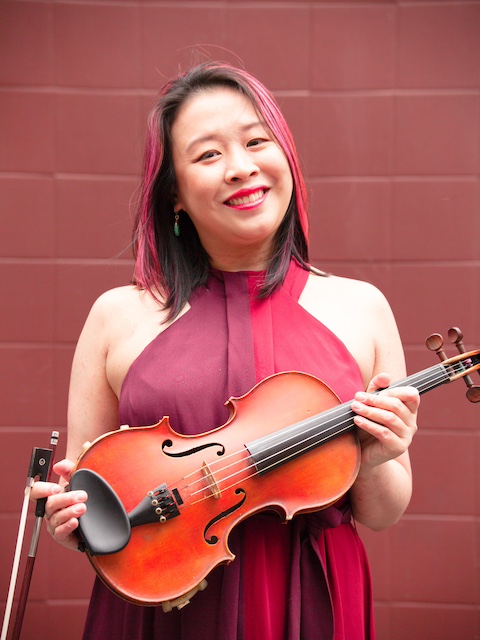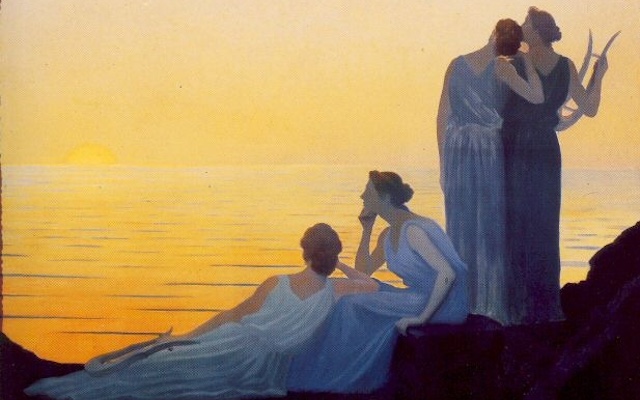The Romantics
Conductor: Andrew Groch
Date: Sunday 24th March 2024
Time: 2.30pm
Venue: Preston City Hall
The Music
Emilie Mayer
Faust Overture, Op. 46
Chausson
Poeme
Violin: Tiffany Cheng
Tchaikovsky
Symphony No. 5
Tiffany Cheng

Born in Wollongong, Tiffany started playing the violin at the age of four after being inspired by the TV show “Play School”. She began her violin studies with Liana Bonacorsso, Harold Brissenden and Yasuki Nakamura before commencing her tertiary studies at the Sydney Conservatorium of Music with Dr Robin Wilson. In 2014, Tiffany completed a Bachelor of Music (Performance), graduating with First Class Honours. She then moved to Melbourne to study with Sophie Rowell for three years at the Australian National Academy of Music. During the last year of her studies, Tiffany successfully auditioned for her current position in the 2nd violins with the Melbourne Symphony Orchestra.
Her time at ANAM was most enriching as she became a prize winner at the Australian Concerto and Vocal Competition, as well as the Kendall National Violin Competition. In 2017, Tiffany was awarded the Brett and Paul Dean Prize for the Outstanding Performance of an Australian Work for her performance of Julian Yu’s Passacaglia after Biber. Tiffany is also a keen chamber musician, having won the 3MBS Audience Choice award with the Edesia Quartet at the ANAM Chamber Music Competition. She is a founding member of the Tailors Ensemble, a mixed instrumental ensemble which seeks to push the boundaries of chamber music in Australia.
Program Notes
Romanticism
This concert by the Preston Symphony Orchestra is subtitled “The Romantics”, and features three works that typify the aesthetic ideas of what is known as “Romanticism”.
To understand these ideas, it is important to first be aware of what preceded them. It is common to refer to the eighteenth century in Europe as the Age of Reason, where rationality and clarity were preeminent. In literature we might think of the stately rhyming couplets of Dryden and Pope; in philosophy, the formal arguments of Kant or Rousseau; in architecture, the formal lines of neoclassicism; and in music, the confident, clean harmonies of Haydn or early Mozart.
But as the eighteenth century drew to a close, cultural thinkers began to sense there was something missing in the intellectual triumph of rationality – namely, emotion. In the vanguard of this response were poets such as Wordsworth and his focus on nature, and the Germans with their exploration of “Sturm und Drang”, or storm and stress. This change is clearly exemplified in music in Mozart’s later works (e.g. Requiem), or the progression through Beethoven’s symphonies.
Romanticism became the dominant form of cultural expression in Europe for much of the nineteenth century. It essentially brings emotion and feeling to the foreground, and encourages a personal response to a work.
Ultimately, Romanticism too lost its lustre, as writers, composers and artists turned to new ideas such as Realism, Impressionism, Expressionism and Modernism. But the legacy of Romanticism remains particularly dominant in music, and continues to be popular with audiences.
Emilie Mayer (1812–1883)
Emilie Mayer was a successful German composer, whose music enjoyed considerable critical and popular success in her lifetime. A contemporary of Schumann and the Mendelssohns, her musical style straddles the Classicism of the First Viennese School, and the Romanticism that gained favour throughout the nineteenth century. Her body of work includes fifteen overtures, eight symphonies, a piano concerto and opera, together with extensive chamber music.
Mayer grew up in an affluent family in Friedland, a small town in the north-east German state of Mecklenberg. She received a present of a grand piano for her fifth birthday and commenced lessons.
In 1840, at the age of 28, her life took a dramatic turn following the suicide death of her father. She took the bold step to move to the larger town of Stettin (modern Szczecin in Poland), where she commenced compositional studies under Carl Loewe. Encouraged by success in Stettin, she moved to the Prussian capital Berlin in 1847, where she undertook further study of counterpoint with Adolf Marx and instrumentation with William Wieprecht.
Mayer’s professional career blossomed in Berlin. She began publishing her works, and in 1850 was feted in a concert at the Royal Theatre dedicated entirely to her compositions. Her continuing success saw her tour Germany, France and Austria to promote her work, returning to Berlin in 1876 where she played a prominent role in the cultural life of the city.
Mayer’s music was critically discussed during her lifetime, and she was included in various contemporary encyclopedias of composers. After her death, however, her presence faded, and her work became largely forgotten in the twentieth century. Astonishingly, there is no entry at all for her in the 1980 New Grove Dictionary of Music and Musicians. Much of her compositions remain in manuscript form only, unpublished and unrecorded.
More recently, her music is being rediscovered and performed. The bicentenary of her birth in 2012 was a major impetus, and the world is once again learning to enjoy the work of Emilie Mayer.
The Overture to “Faust” is a late work, from 1880. It shows Mayer in full romantic mode, with dramatic moods and colourful orchestration. Like many composers in the nineteenth century – such as Liszt, Wagner, Berlioz, Gounod and Schumann – Mayer was drawn to the subject of Faust from Goethe’s play telling how Faust is tempted by the devil Mephistopheles to sell his soul for knowledge and transcendent experiences.
Mayer’s concert overture is not a narrative response, however, charting the play’s characters or scenes. Rather, it is abstract and imagistic, suggesting ideas and emotions. There are nevertheless a few enticing connexions to the dramatic work: the suggestive insinuations of the opening theme invoke the tempting discourse of Mephistopheles; and the manuscript’s inscription “Sie ist gerettet” (‘She is saved’) invites a reference to the play’s heroine Margarete.
Ernest Chausson (1855–1899)
Chausson was born into an affluent family in Paris, living his short life at the centre of French music and culture. He was friends with composers, artists and writers, as well as being secretary of the National Society of Music.
His work for violin and orchestra Poème was written in response to a commission by Belgian composer Eugène Ysaÿe for a violin concerto (Ysaÿe had the reputation ‘King of the violin’ at the time). The subsequent work is much freer in form than a traditional concerto. Chausson leaves behind the “sturm und drang” of earlier Romanticism, and instead embraces the newer Impressionist ideas of the day, in a sustained rhapsodic portrait. Tone and colour are more prominent than rhythm or structure, and the orchestral accompaniment remains a subdued palette over which the solo violin soars up and down the fingerboard in virtuosic displays.
Pyotr Ilyich Tchaikovsky (1840–1893)
Tchaikovsky’s fifth symphony is a mature work that displays all of the composer’s skills of orchestration, structure and purpose. There is a distinct unity of theme across all four movements, yet such is Tchaikovsky’s creativity that each manifestation is unique in its own way.
While the symphony has no obvious narrative theme, there is a clear trajectory across the four movements. The first movement is sombre and ominous, as if the heavy hand of fate lies over the music. The second movement opens with a haunting horn solo before the oboe heralds the main lyrical melody like a shaft of sunlight, which builds to a passionate exposition from the whole orchestra. Tchaikovsky turns his theme into a series of waltzes for the third movement, before re-working the opening motif into a heroic mode, to finish with an energetic triumphant march.

